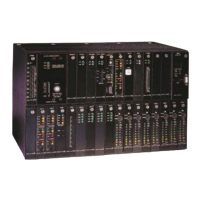Chapter 5. Diagnostics
163
B7 Alarm
The Bit 7 Zeros Suppression Alarm (B7) LED illuminates if the D/I Mux III has been programmed
for bit seven zero suppression. While historic, this type of zero suppression is rarely used, and
should not be used for data circuits.
BPV Alarm
The Bipolar Violations Alarm (BPV) LED illuminates whenever the LIUs detect a series of bipolar
violations.
0-DEN Alarm
The 0-Density Alarm (0-DEN) LED illuminates if the LIUs detect that the T1 span has exceeded
the maximum number of zeros allowed.
AIS Alarm
The Alarm Indication Signal (all ones alarm), also known as the Blue Alarm, (AIS) LED will
illuminate whenever the LIUs detect all ones on the T1 span.
Loop Codes Alarms
There are two Loop Codes Alarm (LP CODES) LEDs included on the front panel. They are listed
and described as follows.
RX
The Receive (RX) LED illuminates whenever the LIUs receive a loop code via the T1
span. This function only works if the D/I Mux III has a CSU (Model 30318-xxx) installed.
TX
The Transmit (TX) LED illuminates whenever the D/I Mux III sends a remote loop code
from the LIUs. As with the RX Loop Code Alarm, this function only works when a CSU
(Model 30318-xxx) is installed in the shelf.
Alarm Contacts
The alarm contacts at the back of the D/I Mux III shelf allow visual and audible alarm systems to be
connected to the multiplexer. The contacts are isolated and normally open, and are controlled through
the Common Control Unit/Multiplexer Control Unit (CCU/MCU). The major and minor alarm contacts
close during corresponding alarm conditions as shown in Table 5-1. The audible alarm contacts can be
opened manually by selecting Alarm Cut-Off (ACO) in the software, or by depressing the ACO push-
button on the CCU/MCU front panel.

